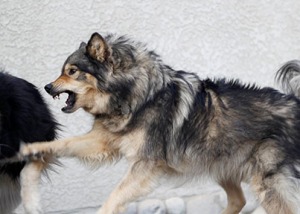 It happened again. A dog that was known to have aggression issues attacked a person, severely mauling the woman. In this case the dog was in a city animal shelter, and the person attacked, Priscilla Romero, was a kennel worker with 10 years experience. Now, before you go dismissing the incident as an acceptable risk of the job, think about this: the dog, a pit bull, had a known history of aggression. Prior entries in the computerized behavioral records stated that the dog had previously bitten but did not break skin. Another entry cautioned, “Be cautious of this dog—dog will growl, bare teeth and tries to bite as I’m trying to open the kennel door to pick up empty food bowl.” Romero was rushed to the hospital in critical condition and may need numerous reconstructive surgeries.
It happened again. A dog that was known to have aggression issues attacked a person, severely mauling the woman. In this case the dog was in a city animal shelter, and the person attacked, Priscilla Romero, was a kennel worker with 10 years experience. Now, before you go dismissing the incident as an acceptable risk of the job, think about this: the dog, a pit bull, had a known history of aggression. Prior entries in the computerized behavioral records stated that the dog had previously bitten but did not break skin. Another entry cautioned, “Be cautious of this dog—dog will growl, bare teeth and tries to bite as I’m trying to open the kennel door to pick up empty food bowl.” Romero was rushed to the hospital in critical condition and may need numerous reconstructive surgeries.
The article goes on to describe other incidents where dogs who were known to act aggressively were offered to the public for adoption. But the problem is far from being limited to one or a network of shelters. There have been numerous incidents where dogs adopted from various shelters or rescues have bitten a person or injured or killed the other dog in the home. The “no kill” policy of some organizations, stretched beyond what “no kill” was meant to be (no euthanasia unless a dog is dangerous or seriously ill), allowed those dogs to be adopted in the first place.
I spent a lot of time in the ’90s at L.A.’s West Valley shelter, first as a volunteer and then volunteer coordinator, often spending 30-40 hours a week there. I was also an emergency hire for the East Valley shelter. And I’m the first to say that it can be difficult to judge a dog’s behavior in a kennel environment, especially since many are fearful when first impounded. These dogs are in a new environment surrounded by unfamiliar smells and sounds, not knowing what to expect, and unfamiliar people are entering their space. Showing teeth or even growling while backing away under those conditions are not, in my opinion, unforgivable sins indicating euthanasia. The dog should be given a chance to acclimate and settle in before being assessed for temperament, especially since a previous owner’s description of behavior might not be accurate. However. There are dogs who come in with known bite histories, who show aggression toward kennel or rescue workers, and who are still adopted out. Why? So the organization can proudly boast about how they’re “no kill?” Again, this is not what no kill was meant to be.
While the dog who is still up for adoption after biting, injuring or worse is awaiting a home, he is taking up the space of a perfectly nice dog, or more likely many adoptable dogs, who will be euthanized because the rescue or shelter has no space. How does that benefit dogs? And what about the dog with known aggression issues who is adopted into a home? Whose fault is it if the dog injures or even kills a person or another dog? The blame lies squarely on the shoulders of whoever knew about those issues and still made the decision to send a potential deadly weapon out into the public. If more rescues and shelters were held legally accountable, I wonder how many aggressive dogs would be adopted out.
The other issue is that dogs who are difficult to adopt out because of aggression or unstable temperament sit in shelters or rescues for months and sometimes even years, and many are miserable. There is a vast difference between a legitimate rescue keeping a dog long-term while providing physical and mental stimulation, affection and training, etc. until the dog can find a home, which is laudable, and keeping a dog who could pose a danger locked up until…what? Until the dog degenerates mentally and physically? Until he can go back out into the general public and yet again pose a danger?
As a trainer, behavior specialist, passionate dog lover, and someone who co-ran a rescue, I am the last person who would ever recommend euthanasia for a dog without there being a solid reason. But there has to be a balance between our compassion for dogs and common sense when it comes to dogs who are truly dangerous. Some organizations properly use the term “no kill” to mean “unless the dog is truly dangerous or ill.” It’s the misuse and misinterpretation of the term that’s problematic, along with the fact that the general public assumes that “no kill” means no dog is ever euthanized, period. So rather than having the knee-jerk reaction of “how wonderful!” when we hear that an organization is “no kill,” let’s dig deeper and consider what the term really means for that particular group, those dogs, and the safety of the general public.
_________________________________________________________________________________________
You can find my books, seminar DVDs and blog at www.nicolewilde.com. Don’t want to miss a blog post? Subscribe above and be notified by email of new posts. You can also sign up for my Training Tips Tuesdays by going to www.nicolewilde.com and clicking on Join Nicole’s Inside Scoop List. You’ll get free tips on training and behavior weekly! You can also find me on Facebook and Twitter.



 Posted by wildewmn
Posted by wildewmn  I recently came across an article in which a dog who was known to be “nervous, growling, and didn’t like children” was sent away for training. While in the trainer’s care, the dog mauled her. According to the lawsuit, “With the pit bull still attached to her left breast, Ms. Rickles backed into a laundry room where the dog released his grip, enabling Ms. Rickles to close the door. The pit bull then broke through the door and attacked Ms. Rickles a third time, latching onto her left arm and breaking it in two places.” After this horrific incident, you might assume the dog would have been euthanized. Indeed, a Texas judge did sentence the dog to death. However, the dog’s owner pleaded for the dog’s life, and it was agreed that the dog would go to the training facility of a well-known trainer who would “take the pit bull and rehabilitate it” and not release it until it was “fully deemed a safe member of society.”
I recently came across an article in which a dog who was known to be “nervous, growling, and didn’t like children” was sent away for training. While in the trainer’s care, the dog mauled her. According to the lawsuit, “With the pit bull still attached to her left breast, Ms. Rickles backed into a laundry room where the dog released his grip, enabling Ms. Rickles to close the door. The pit bull then broke through the door and attacked Ms. Rickles a third time, latching onto her left arm and breaking it in two places.” After this horrific incident, you might assume the dog would have been euthanized. Indeed, a Texas judge did sentence the dog to death. However, the dog’s owner pleaded for the dog’s life, and it was agreed that the dog would go to the training facility of a well-known trainer who would “take the pit bull and rehabilitate it” and not release it until it was “fully deemed a safe member of society.”






